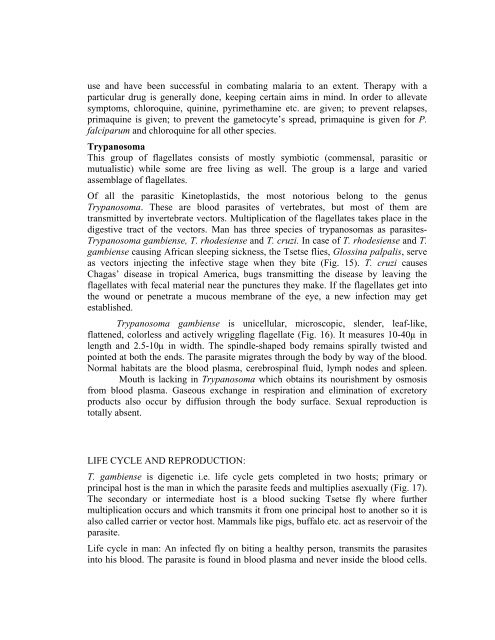ANIMAL DIVERSITY – I (NON-CHORDATES)
ANIMAL DIVERSITY – I (NON-CHORDATES)
ANIMAL DIVERSITY – I (NON-CHORDATES)
Create successful ePaper yourself
Turn your PDF publications into a flip-book with our unique Google optimized e-Paper software.
use and have been successful in combating malaria to an extent. Therapy with a<br />
particular drug is generally done, keeping certain aims in mind. In order to allevate<br />
symptoms, chloroquine, quinine, pyrimethamine etc. are given; to prevent relapses,<br />
primaquine is given; to prevent the gametocyte’s spread, primaquine is given for P.<br />
falciparum and chloroquine for all other species.<br />
Trypanosoma<br />
This group of flagellates consists of mostly symbiotic (commensal, parasitic or<br />
mutualistic) while some are free living as well. The group is a large and varied<br />
assemblage of flagellates.<br />
Of all the parasitic Kinetoplastids, the most notorious belong to the genus<br />
Trypanosoma. These are blood parasites of vertebrates, but most of them are<br />
transmitted by invertebrate vectors. Multiplication of the flagellates takes place in the<br />
digestive tract of the vectors. Man has three species of trypanosomas as parasites-<br />
Trypanosoma gambiense, T. rhodesiense and T. cruzi. In case of T. rhodesiense and T.<br />
gambiense causing African sleeping sickness, the Tsetse flies, Glossina palpalis, serve<br />
as vectors injecting the infective stage when they bite (Fig. 15). T. cruzi causes<br />
Chagas’ disease in tropical America, bugs transmitting the disease by leaving the<br />
flagellates with fecal material near the punctures they make. If the flagellates get into<br />
the wound or penetrate a mucous membrane of the eye, a new infection may get<br />
established.<br />
Trypanosoma gambiense is unicellular, microscopic, slender, leaf-like,<br />
flattened, colorless and actively wriggling flagellate (Fig. 16). It measures 10-40µ in<br />
length and 2.5-10µ in width. The spindle-shaped body remains spirally twisted and<br />
pointed at both the ends. The parasite migrates through the body by way of the blood.<br />
Normal habitats are the blood plasma, cerebrospinal fluid, lymph nodes and spleen.<br />
Mouth is lacking in Trypanosoma which obtains its nourishment by osmosis<br />
from blood plasma. Gaseous exchange in respiration and elimination of excretory<br />
products also occur by diffusion through the body surface. Sexual reproduction is<br />
totally absent.<br />
LIFE CYCLE AND REPRODUCTION:<br />
T. gambiense is digenetic i.e. life cycle gets completed in two hosts; primary or<br />
principal host is the man in which the parasite feeds and multiplies asexually (Fig. 17).<br />
The secondary or intermediate host is a blood sucking Tsetse fly where further<br />
multiplication occurs and which transmits it from one principal host to another so it is<br />
also called carrier or vector host. Mammals like pigs, buffalo etc. act as reservoir of the<br />
parasite.<br />
Life cycle in man: An infected fly on biting a healthy person, transmits the parasites<br />
into his blood. The parasite is found in blood plasma and never inside the blood cells.
















